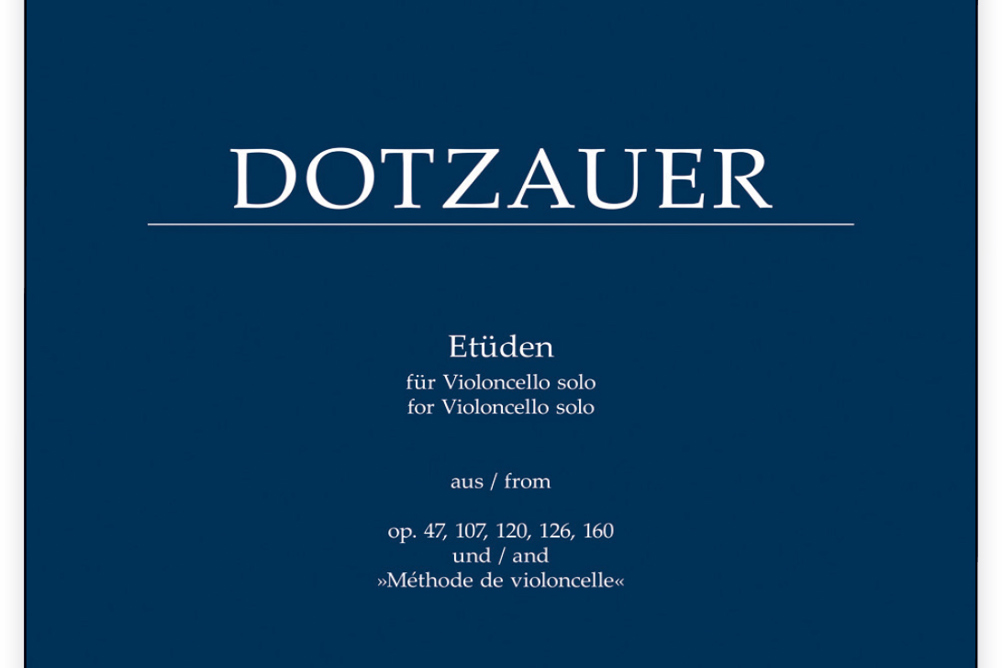
This selection of etudes is aimed at beginner to intermediate level cellists. The cellist and teacher Justus Johann Friedrich Dotzauer (1783–1860) was widely known as a prolific composer of cello studies for beginner to virtuoso players. He often presented his own opus collections, spanning a range of levels, and historically the studies have been incorporated into well-known method books.
The editor of this collection from Bärenreiter is George Kennaway, the respected cellist, teacher and musicologist with ties to the universities of Leeds and Huddersfield. He is the author of Playing The Cello, 1780–1930 (Routledge, 2014), an innovative study of 19th-century cellists and cello playing, showing how the concepts of posture, technique and expression changed over time. His editorial note on how material for the collection was selected is informative, but also useful for teachers wanting a sense of when these studies could be used and for which student. The foreword, in addition, includes information (in English and German) on performance practice.
The studies are presented here with their opus numbers, a practice not often found in modern publications. We therefore get a sense of where these came from in terms of the composer's technical and stylistic development. The printing of the edition is clear, and Dotzauer's fingerings and bowings from the first edition have been maintained; occasionally, editorial markings are added in brackets.
There is a balanced mix here of fast-tempo studies to develop agility, and slower pieces, with longer cantabile lines to develop expressive playing, such as nos. 6, 21, 25 and 29. Dotted rhythms feature in nos. 7 and 14, which can help students develop rhythmic accuracy and power in the left hand. Double stops – always a great way for cellists to improve left-side alignment and hand shapes, as well as intonation – are found in nos. 11, 25 and 30, while study 18 offers the opportunity to practise left-hand shapes across three strings.
It is notable how long some of the studies are in this first volume, which is aimed at early-stage learners, compared with much of what teachers present today. One can only guess that teachers in the 19th century were working under very different conditions, not restricted by the short lesson times that teachers often face in schools today. A useful approach, therefore, to manage stamina and concentration in some students, might be to split the longer studies across a few lessons.
While some of Dotzauer's own bowing variations appear in the volume – for example, in nos. 15 and 16 – other studies have no such markings. Instead, options for bowing are described in the separate pages of the editorial commentary, trusting that teachers, parents and students will read this and decide how best to apply the information. Personally, I feel this may be a missed opportunity, as students can gain a lot from seeing bow patterns on the page, particularly in historical repertoire; this helps students recognise patterns in other pieces that they are studying. Instead, here it is left to the ingenuity of the teacher to find an appropriate means of communicating these and making them memorable.
Looking at a couple of the studies with longer slurred/legato bowings, a question that arises is: what kind of bows were students using in Dotzauer's time? Some students using fractional-sized bows might struggle to deal with the control required in studies such as nos. 6 and 20. Some older editions of these pieces have addressed this; but here, it seems academic accuracy has taken priority over thinking practically about how younger students with small bows, and likely developing bow technique, might manage these passages.
While Dotzauer wrote the majority of his etudes for solo cello, he did at times include duet parts in the original, such as in his Op. 126 collection, and in his Methode. Dotzauer's own duet parts have been removed for this collection, and so all the studies are presented for solo cello only; the editor has indicated where this is the case.
As a postscript, one of the most familiar volumes of Dotzauer is the Klingenberg edition entitled 113 Exercises, which offers a progressively structured if somewhat high intensity approach. This Bärenreiter volume contains pieces of historical and academic interest, but in a way that streamlines the progression while retaining musical variety.
Dotzauer: Etudes for Violoncello Solo, Vol. 1
Bärenreiter BA12101, £21.50




